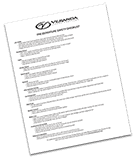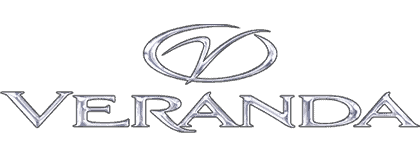Ignition, Throttle & Trim
Veranda Luxury Pontoons is proud of our longstanding partnership with Yamaha Outboards because their engines give the turnkey reliability and efficiency that you deserve. This video segment will educate you on how the ignition and throttle work. The Yamaha ignition key switch and throttle are located on the starboard side of the console on all Veranda Luxury Pontoons models.
The first thing you should do before starting the engine is to check the stern and make certain no one is swimming directly behind you or hanging off the stern swim platform. It’s also important to make sure your swim ladder is stowed away in the upright, locked position and that no tow ropes or fishing lines are in the water. Finally, check to see if the motor is free of any obstructions and its position in the water.
Next, put on a properly fitting PFD (personal floatation device) for your safety and that of your passengers. It is recommended all passengers have a properly fitting PFD on when underway.
Take a seat at the helm and grab the metal clip on the end of the red safety lanyard and attach it to the lower section of your PFD. DO NOT wrap the cord around your wrist or arm. Now grab the black quick-release clip on the other end of the lanyard and push it upward onto the round release button just under the ignition switch until it locks into place.
Make sure the throttle is in the neutral, upright, and centered position, not leaning forward or backward. Adjust the motor until the prop and lower unit are submerged by pressing down on the trim switch, located on the throttle handle. Insert the key into the ignition key switch assembly and turn it to the right to start the outboard. Once it kicks on you can release the key. Dry starting your outboard can damage the engine. Be sure to test the kill switch by pulling on the safety lanyard until the quick release clip pops off the quick release button. Your outboard should stop instantly. Replace the clip and restart your engine.
The throttle, located on the right side of the helm, controls the direction and RPM of the propeller on the outboard, making the boat move forward or in reverse. The neutral position is in the middle when the lever is positioned upright in the center of the shifter. Moving the lever further forward will take it into forwarding idle with the motor in gear, which is a steady slow speed. Continuing to push it forward will increase the speed until it maxes out in full forward. Pulling the lever from the neutral back toward the stern will put it into reverse idle, which puts the motor in gear. Continuing to pull it back further will increase the reverse speed until you’re all the way down in full reverse. Always use a brisk and decisive movement when shifting into or out of gear otherwise you will hear a grinding down from the outboard. Always pause in neutral before shifting from forward to reverse, or reverse to forward. When traveling at high speed, never shift into reverse while the boat is in forward gear. Always keep the shift control clean and clear of obstructions.
Knowing how to handle the throttle and trim on your Veranda is essential for safe, proper, and efficient operation.
To get underway moving forward, you will want to gently push the throttle towards the bow until the engine engages. As you begin to advance the throttle further, the outboard will begin to increase the RPMs on the propeller and move faster. If you wish to reverse the pontoon, you will want to pull the throttle back towards the stern until it’s in neutral and continue moving it back until the engine engages in reverse and the pontoon begins to move astern. Just a reminder that pontoons do not have brakes, so learning to use the throttle for slowing down or changing direction will give you more control.
For instance, if you’re motoring in and approaching a dock, you can slowly pull the throttle back into reverse to slow down the forward movement of the vessel. Repeating quick, short bumps forward and back to neutral will slowly inch your pontoon forward.
To shut off the engine, just move the throttle into neutral and turn the ignition key to the right.
Please remove the red safety lanyard from the ignition switch and place it in a storage compartment when not in use. Continued exposure to UV light from the sun will damage the lanyard, making it brittle.
We also recommend you keep a spare lanyard on your pontoon to ensure you’re always able to get back should you lose the first one.
The trim button is located on the top of the throttle lever and uses hydraulic rams to change the angle of the outboard motor to the boat transom. When you press the trim button down, also called negative trim, you move the outboard deeper down in the water and closer to the transom. Trimming up, also called positive trim, will lift the outboard’s drive shaft and propeller higher up in the water and further from the transom. You can refer to the trim gauge or Simrad unit on your dash for the trim position. When unloading or loading at the ramp, or anytime you’re in shallow water be sure to trim up to protect your prop and motor. As you gain experience, you will be able to feel it in the way the boat performs, hear it in the sound the motor is making, and see it in the position of the washout on both sides of your boat and in the steam of water flowing from the lower unit. As you get up on plane, your bow gets up out of the water and the wake moves further to the stern of the boat as you increase your speed.
Accelerating, Turning & Stopping
Be sure to announce to the passengers that you are about to get underway. Check gauges to make sure the water depth is deep enough to run. To start out from idle, you will want to trim the motor all the way down, shift the throttle into forward idle, and slowly move it into forward throttle range, which increases your speed. Once the pontoon is underway, you will want to trim up for 3-second increments and observe how the boat performs. This should get the bow up and stern down, making the prop parallel to the water surface giving you optimal performance and improved fuel economy. Adjust the trim smoothly as you increase your speed.
As you approach a turn, you will want to pull the throttle back a bit to slow your speed, announce to the passengers that you are about to turn, then begin the turn while also bringing the trim down. Your motor should be fully trimmed down by the time you are in the sharpest part of the turn. You can now begin to add throttle to increase your speed. Once you have completed the turn and straightened out, you will want to smoothly trim back up to re-establish cruising speed. If you make too sharp of a turn, the stern of your pontoon can kick up sideways, causing your passengers to get flung around on the interior and potentially hurt. It is best to plan your turn in advances and make them a gentle sweeping maneuver. In windy conditions or areas with strong currents, it is best to position the bow downwind, in the opposite direction of the wind.
Unlike a car, boats do not have brake pedals to stop with. Your forward momentum will continue to move your boat long after you put the throttle into the neutral position. To stop, you will need to shift into neutral and then pull the throttle back into reverse. Space and time are your best friends. With experience, you will learn to ease down in speed when approaching a dock or land and then gently make small bumps on the throttle in reverse to slow your momentum down.
Navigational Procedures & Tips
The boat overtaking or passing must yield the right-of-way to the boat being passed. The overtaking boat must make any adjustments necessary to keep out of the way of the boat being passed. The boat being passed has the right-of-way and must hold its course and speed. Remember to sound a signal to avoid potentially confusing and hazardous situations. The burdened vessel is the one coming up from behind about to overtake a vessel. The boat being overtaken is the privileged vessel. Use one short blast to pass on the port side. Use two short blasts to pass on the starboard side.
When two boats meet head-on, neither boat has the right of way. Bot boats should decrease speed, turn to the right and pass port-to-port. If both boats are on the left side of the channel each vessel should sound two short horn blasts and pass starboard to starboard.
In crossing situations, the boat to the right from the 12 o’clock to the 4 o’clock position has the right-of-way and must hold course and speed. The boat without right-of-way must yield and pass to the stern of the privileged boat. Boats going up and down the right have the right-of-way over boats crossing the river.
Here are a few more helping navigation tips to consider:
- Any time you are close to shore, in shallow water or have underwater obstructions close to the surface you will want to trim the motor up to avoid damaging the bottom of the lower unit and prop.
- To maximize draft in shallow areas, you’ll want to trim up until prop and water intake on the lower unit is underwater.
- Never keep the motor out of the water whiles it is running.
- If you don’t see water flowing out from the lower unit on your outboard, you know it’s either sucking air because it is trimmed up too high and the water intake is out of the water or because the water intake is clogged.
- Point the motor in the direction you want to go then shift the throttle smoothly and slowly.
- Use short applications of power, re-direct the drive, then use another. Repeat as necessary.
- Always be scanning the water for other boats, land, and floating debris, such as floats, tree branches and containers. The recommended distance to look is 100 feet ahead when running.
- Plowing is when you’re not going fast enough to get the logs out of the water and you push water in the front of the boat.
- Porpoising is an uncomfortable position when the bow bounces up and down because you’ve brought the stern down too low. Over time, you will discover a sweet spot to trim to at each speed where the boat has the smoothest ride, optimal performance, and the best fuel economy.
- You may need to adjust the weight distribution in your boat (position of passengers and heavy gear) a bit to improve performance and fuel economy. RPMs increase as you change the angle. Improve efficiency, improve performance.
- Never go too fast in reverse or you’ll swamp the stern.
For additional information please look inside the Basic Boating and Safety Manual, included in your Veranda dry bag, reach out to your nearest authorized Veranda dealer or visit www.verandamarine.com.



